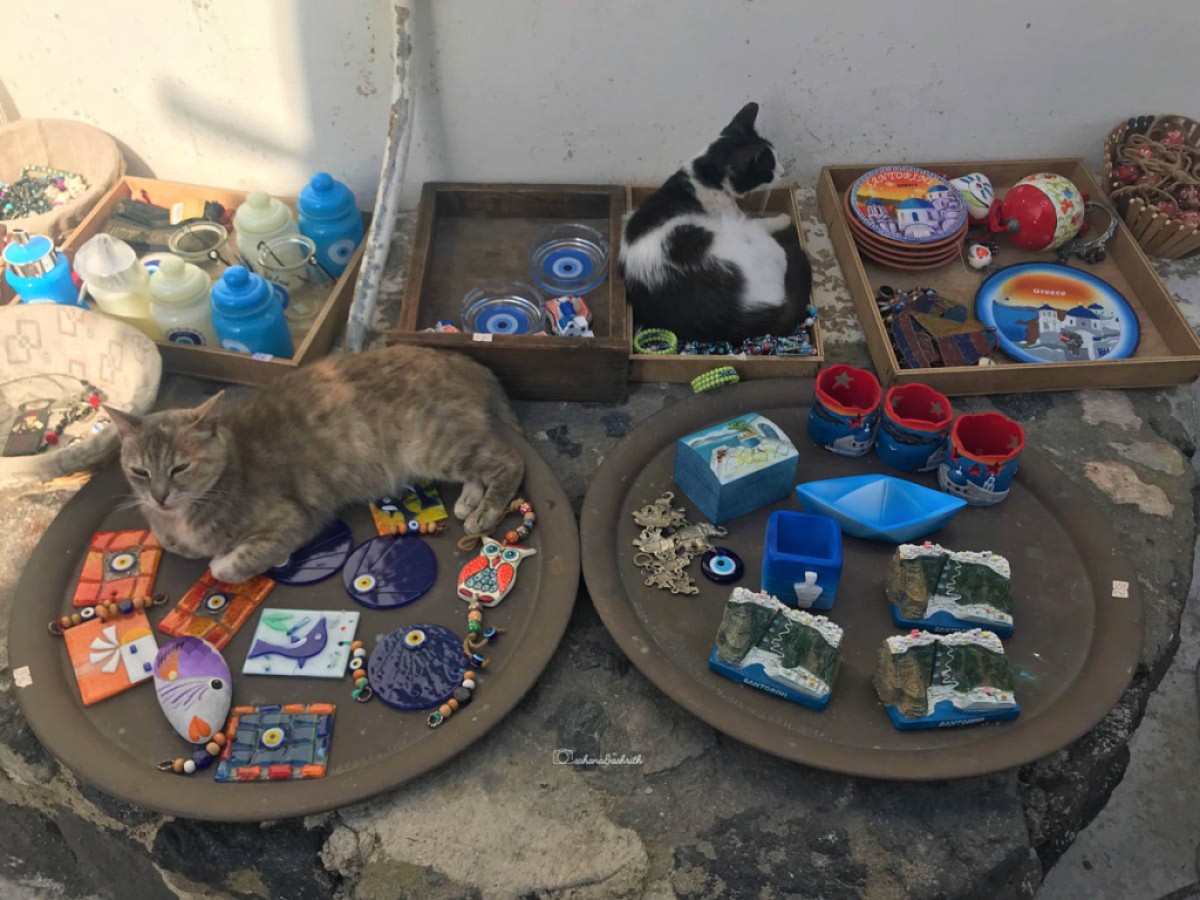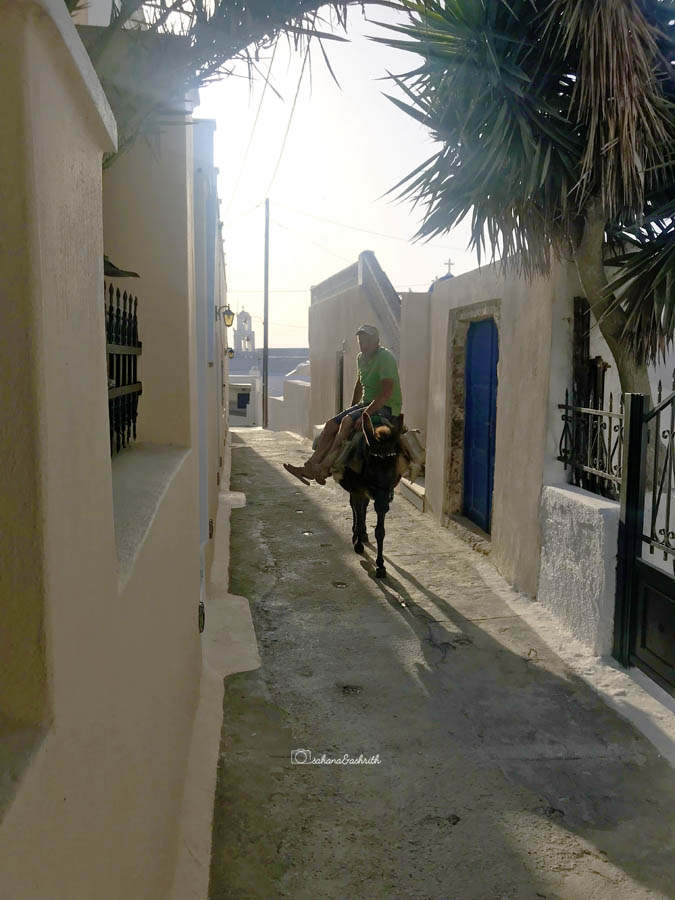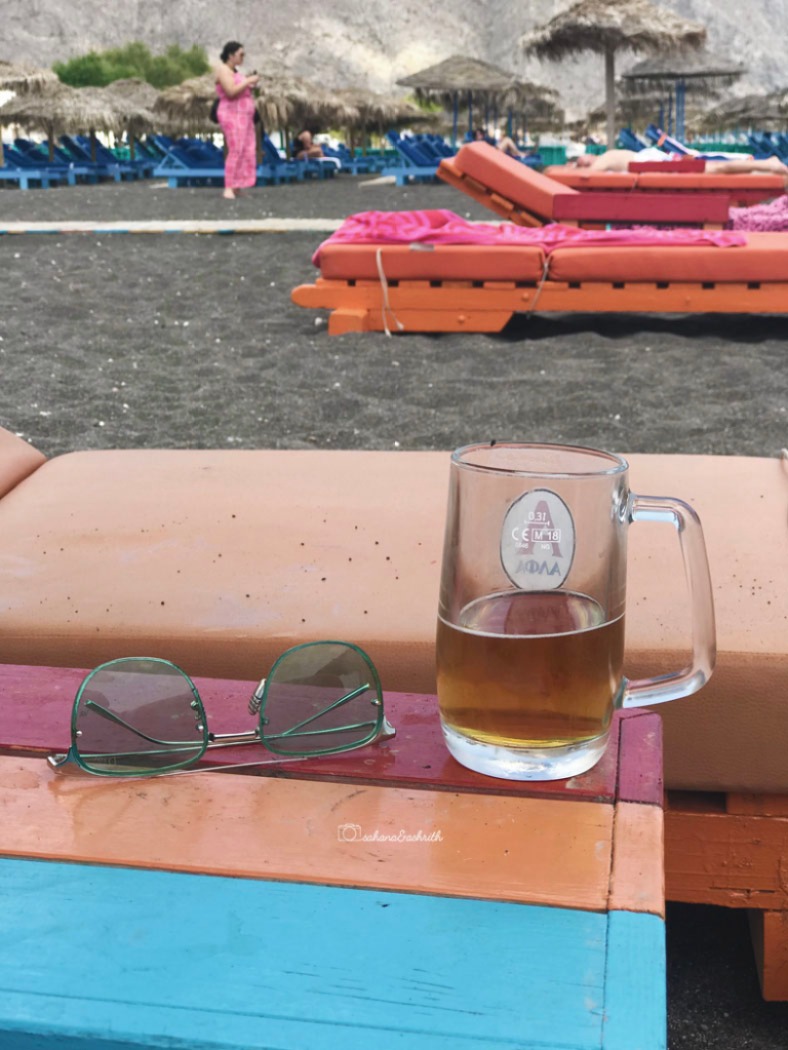As much as I loved Santorini, I don’t deny that it is a touristy spot. – Obviously, it is bound to attract people globally with its beauty – So No complaints. On the 4th/5th day of our stay in Santorini, I wondered how authentic Cycladic villages looked and functioned. When I look back, I am glad I did explore the offbeat place Pyrgos in Santorini. Now I know what the authentic Cycladic village feels like.
This post is about two amateur travellers’ stories of visiting a” non-touristy village and the most beautiful part of Santorini. And why you should experience the same while you holiday in Santorini.
- Exploring Pyrgos
- Lazing on the black sands of Perissa
Is there a bus from Pyrgos to Fira?
The cheapest way to get to Pyrgos is by taking a direct bus from Fira. Suppose you come from another village like Perissa or Akrotiri; you need to get to Fira and take another bus to Pyrgos.
Is Pyrgos worth visiting?
What is the most popular part of Santorini?

The most visited town in Santorini is Oia. No doubt it is beautiful – But we tourists have over-used it.
What is the most beautiful part of Santorini?
If you are curious about how Oia looked before tourists took over the place, go to Pyrgos – an unadulterated Cycladic village.

If you observe the map of Santorini, it is an inverted “C” or a “Prawn” shaped island. Pyrgos is where you can see Santorini as a whole in one sight other than from the sky. If you are a hiker, the view of the Caldera from Saint Eliyas Monastery is the reward. Pyrgos is the place for hikers and seekers. There was never a dull moment in the quiet village. It can take you back in time within a few minutes after you start walking.
The corbeled streets, three bells churches, souvenir shops that looked like cats owned them, half-painted old houses at various levels, older people catching up with neighbours at the church courtyard, a man taking tomatoes down on a donkey and the colourful doors – All these vanish at the end of a shaded alley opening up to the view of terraced tomato farms lined with Aegean sea in the background. The cafes that serve tasty island food for a lower price are an added bonus.
Pyrgos is where you get to see locals living. Pyrgos stands like an oasis in the middle of Santorini’s tourism madness.

Pyrgians love Pyrgos – they want to preserve every aspect of their village.
The economy is important, but they aren’t yet corrupted by mass tourism. Pyrgos is neither swamped by sunset spotters nor is it the first choice among the hordes of cruise ship passengers. Its charm is different: subtle, less picture-perfect, little advertised and more impressive because it is original.
What is a Cycladic village?

The southern part of Greece in the Aegean sea between Greece’s mainland and Turkey is the Cycladic islands. So you find these sugar cube white houses built along with the steep slope in many parts of Greece and some parts of Turkey. The settlement pattern may look random, but every Cycladic village shares a few familiar characteristics—vineyards, churches, a narrow maze of alleys paved with flagstones and sugar cube houses built on top of each other or attached to the other. The houses are like a cluster of grapes – touching each other.
If you observe the cluster of these houses, the house front faces south with windows and doors to receive good sunshine during cold winters. North wall usually gets attached to the adjacent house or remains with no openings to avoid chilling breeze. The thicker walls with smooth-edged corners keep the inside cooler during harsh summers. ( Wall thickness is almost 2 to 3 times thicker than the usual bricks of modern days)
Balconies and courtyards have been part of Greek architecture since the Minoan time. So the same continues in Cycladic villages too.
The sense of freeness when you see the turquoise blue Aegean sea is exceptional, and it is the best way to relax on a Cycladic vacation.

These villages are perfectly designed to bear all kinds of climates along with fantastic minimalist aesthetics. The azure blue windows for Church domes and pastel colours for the home doors and windows add charming vibrance to the whitewashed buildings.
Why is it all white and Blue?
There are tens of reasons and stories behind why the Cycladic villages are Blue and white. Even in Santorini, when you ask a baker or a cafe owner, each one believes in a different reason. I was 100% convinced that whitewashing with lime was cheaper, and the colour white plus domes reflect the hear back, keeping the inside of a home cooler in harsh summer. Then where did the blue dome or blue windows come into the picture? Some locals say that Greeks wanted to express their dissent against their government when Greece was under Ottoman rule. So they began to paint parts of the houses with blue paint. So the dome, doors, and windows got blue – the colour of the Greece flag.
The other theory says that the Greece president ordered people to paint houses white during the military rule.

Why do we love Pyrgos most?
After our sailing tour, the captain arranged a taxi to get back to our room or any part of Santorini. Staring at the taxi fare board in Oia port for different localities, we chose the town Pyrgos- Neither Rick Steves had mentioned it nor Haraa from Dana Villas talked about it. The driver was indeed delighted when we asked him if he could take us to Pyrgos. He was a religious person. He said, “whenever I get stressed out at work, I go to Eliyas monastery. It is very calm there. Today I can go there as part of my job of dropping you and visiting the holy place too.” ( Of course, the conversation wasn’t this clear, we didn’t speak good Greek, he knew little English. But we conveyed each other what we wanted to)
We crossed many wineries and villages with scattered houses on our way to Pyrgos
Finally, the driver stopped at a place and said,” I can drop you at Eliyas monastery; that is the highest point. But will you be able to walk down 5km to Pyrgos square in this afternoon sun?” Wow, a 5km downhill hike is all good, but not under the scorching sun. So he dropped us somewhere away from the monastery so that our hiking got lighter. The view was unique – The white and blue houses looked like little marbles on the giant chocolate brownie. The dry landscape, silver sea, and rugged terrain with a parapet of rubbles were not the usual Santorini sight we had seen before on social media.

The 4km downhill hike isn’t challenging, but the sun wasn’t merciful. As much as we love walking with a unique view, the moment we reached the foothill was revealing. The straight road with very few houses here and there took us to the town square.
Sitting under a roof was a much-needed break after an hour of walking in the sun—every time we check the rates on the menu before we enter a restaurant. But the 30*C temperature made us forget everything. So we took the menu card and ordered two mocktails.
Sipping the refreshing mocktails in the cosy cafe, we felt a great sense of relaxation. Sailing and walking had made us lazy. Shaking off that lethargy, we stepped outside the cafe onto the corbelled streets of Pyrgos without knowing what awaited us ahead. The walk began on the cobbled square to the town that showed only one of its churches hiding everything behind its maze of alleys.

An older man on the walkway was talking to someone as if he was fighting with that.
The Greek conversations are louder, and as a foreigner, you feel they are quarrelling. There was hardly anyone visible in the vicinity after the first climb of stairs. While one house stood painted in white, the other home was waiting to rejuvenate with its faded facade. Few houses were locked but stood as if they were cursed and left to die. The peeled plaster, faded door below a white refurbished house reflected a time gone by and present.

There was no rush here; no tourists were trying to capture a perfect social media frame. The time was moving at its own pace with nobody’s influence. We walked up, wondering if anyone was living there or if it was an abandoned village. There was a tiny open shop selling souvenirs. The owner was friendly, but the co-owners were sexier.

Who lives in Pyrgos, Santorini? Lots of cats and a few humans
Because that shop owner was the first-ever human we met after climbing up, we tried to crack up the conversation. As usual, we spoke in broken Greek+English slowly, and he responded slowly by joining a few words. When asked who lives here in the village,” Very few. Older men and artists mainly. Youngsters prefer to live in Fira and Oia because of job opportunities. Those who live here are either into farming, vineyards or artists. Houses aren’t abandoned; the owners come and go often.”

Buying little souvenirs from the shopkeeper, we walked ahead – there was no plan other than following the maze to feel the town. There were a countable number of visitors enjoying the experience beyond searching for a picture-perfect spot. The breeze whooshing in the narrow alley was audible – the place was silent with utter mutter of people.
We walked whispering until we hit the top level. In need of some shade, We sat on the steps of an abandoned house just at the end of the twisted alley. It opened to this crazy view that we never knew existed! The high terraces with tomato fields, vineyards, mountains and the Aegean Sea are in the background. This is the view hardly any social media portrays. The tomatoes you eat in Fira and Oia come from there! Pyrgos was a bundle of surprises packed.

Unknowingly we circled the village! After entering from the south, we ended up at the North which faces a farming terrace on the horizon
We did meet a few fellow travellers on our way; everyone seemed to be enjoying the place at their own pace matching it with the slow pace of Pyrgos. There was none to disrupt us except a few cute furry buddies. There are lots of cats in Santorini, but Pyrgos looks like home for them.

Unintentendedly, we entered the alleys again from the back end. The famous Venetian castle is open to all with no entrance fees invited us. The castle isn’t the one like in Disney movies, but you can feel the richness. Yet again, it is maintained by locals who love their village more than anything.
We began the downhill walk by the whitewashed walls on one side and stalls of artists on the other. We heard clopping but couldn’t spot the source. The alleys are so narrow that no horse can come through. We got up and walked away to the broader street, thinking of a horse. Instead, there was a man with two empty saddlebags on a mule! ( Or is it a donkey?) This was something that we had never expected!

We had enough of wrooming ATVs in Fira and Oia.
But here, a man on Mule like in the olden times. He smiled at us and threw a small tomato from his bag at us, and shouted,” Hareeka.” Later we got to know Hareeka means” Nice to meet you” in Greek. I have had enough of Santorini tomato already, but this was fresh from the farm. It tasted better, maybe because a random stranger gave it out of love.
The clopping faded as we walked further down, and it was more of a “meowing” sound now. The number of people who live in Pyrgos must be equal to the number of cats, maybe! While we wondered from where these cats are appearing, a building popped up with the board saying, “Help us to feed stray animals. So, along with preserving Pyrgos, Pyrgians look after the stray cats. The place looked legit because many Felis Catus was lazing all over inside that building compound. The donation box was hung to their metal gate. Petting a few of them who were outside, we put whatever we could afford into the donation box and walked ahead.


The more you walk in Pyrgos, you understand and observe better. The best part of Pyrgos is the doors! Almost all house doors are different! Initially, we didn’t notice it, but it is very evident in those which are renovated. The grill pattern, architraves, embossing and colour, bring vividity to the place.

We sat on a parapet in one of the side alleys closer to a red-door house and watched an artist painting. We could hear a few men talking and laughing at a distance. Old local men who take care of a community church were conversing under a tree. As We had not visited even one church in Santorini, we decided to go inside this one. One of those local men approached us smilingly and said, ” Come to church”.

He took us inside and offered us a candle showing the board – “Help locals preserve the church by buying candles. Pay as you wish.” We didn’t know how much to pay. We usually know how much to give in our temples, but it was tricky in a foreign land in an unknown village. He sensed this too and said,” No money is low. Fifty cents is also ok” Smilingly, he walked away to avoid any further awkward situation. We lit the candles and sat in the church for a while. The place seemed genuine, and the locals were using the money collected in the right way to restore the church and the village.

The typical Three Bell church of Santorini in Pyrgos
The soulful walk of almost 3hrs took us back to the square. The tourist information centre had displayed bus timings. We had to go to Fira to catch a bus to Perissa and wait for almost 30 minutes for the next bus at the Pyrgos square. When you are in an unknown place, that 30-minute waiting time flies in a fraction of time. We chose the square over the cafe to save money. The sun was coming down, and older people were out to walk; locals returned home from the farms. We sat by the roadside, watching the locals heading back home and having their loud conversations with each other. Most small towns work similarly in every part of the world, perhaps.

While we sat and watched the local life happening, two older men came to us, smilingly began talking! This time they didn’t speak even a word of English, and we didn’t know anything other than “Efahristo’ and “You” in Greek. God knows what they asked and what we replied. We said we were in Perissa, we are from India and showed our fingers to let them know we were married. They were all smiling and making cheerful gestures. A few words we did understand were – Santorini, Fira, marriage, and tour. So I assume that they just wanted to say hello, tourists! The conversation where neither party understood anything other than smiles and laughter was hilarious to end a fine day.

Lazing on the black sands of Perissa
How to Reach Perissa
While the Westside is for the cliffside villages of white cube houses and sunset, the east is about sand and water in Santorini. The direct buses from Fira to Perissa run every 30 to 45 minutes or so.
Why visit Perissa

The apparent reason – is to soak yourself in the sun on black sand and Mediterranean water. If you visit only Fira and Oia like most tourists, you miss the actual beach vacation. Plus, Perissa, with small cafes and clubs, is a calmer alternative for bustling Fira. The sleepy town of Perissa is untroubled by what is happening in Fira, 12km away. During peak season, the sunbed umbrellas may be busy shading the tourists. Still, the town is so that no rush can shake its laid-back vibe.
Best things to do in Perissa

Nothing! It is a perfect place to do nothing! It may be sandwiches and coffee at the local-run bakery Boulangerie or Bob’s bar of Perissa; everything happens slower. This small town is where we stayed for 5 days- a town where most locals know the other. Are you too lazy to take a bus to go somewhere? Hit the beach. Are you back in your room early? Go to a local bakery. Do you want to soak and swim in Mediterranean water and sunbathe later? Go to the beach. With plenty of cafes and clubs on the shore and in the town, you can experience plenty by doing nothing.
The difference between Pyrgos and Perissa:
Pyrgos is a cliffside town but not by the sea, while Perissa is at the mountain’s foot. So you see no windmills, no cluster of white cube houses with a blue dome built at different levels of slopes here.
I won’t say if this is the best beach in Santorini, as this is the only beach town we have visited. However, we were so absorbed by Perissa’s charm and felt content that we didn’t visit another beach, Kalamari. Perissa – A perfect place for a staycation for mid-range travellers.

Found our strolling and lazing stories helpful? Let us know in the comment section below.



Leave a Reply